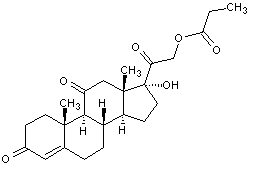
Structural formula
| Business number | 0135 |
|---|---|
| Molecular formula | C23H30O6 |
| Molecular weight | 402.48 |
| label |
cortisone acetate, cortisone acetate, progesterone acetate, cortisol, corticosterone acetate, Pregnant-4-ene-17α, 21-Diol-3,11,20-trione-21-acetate, 21-acetoxy-17α, Hydroxypregnant-4-ene-3,11,20-trione, cortisone 21-acetate, 11-dehydro-17-hydroxycorticosterone acetate, 11-dehydro-17-hydroxycorticosterone-21-acetate, 17,21-dihydroxypregn-4-ene-3,11,20-trione acetat, hormone |
Numbering system
CAS number:50-04-4
MDL number:MFCD00003609
EINECS number:200-006-5
RTECS number:GM9140000
BRN number:2067543
PubChem number:24278306
Physical property data
1. Properties: White or off-white crystalline powder, odorless
2. Density (g/mL, 25/4℃): Undetermined
3. Relative Vapor density (g/mL, air=1): Not determined
4. Melting point (ºC): 237-240 °C.
5. Boiling point (ºC, normal pressure): Undetermined
6. Boiling point (ºC, 5.2kPa): Undetermined
7. Refractive index: 212 ° (C=1, MeOH)
8. Flash point (ºC): 223
9. Specific rotation (º): [α]25D+166°
10. Autoignition point or ignition temperature (ºC): Undetermined
11. Vapor pressure (kPa, 25ºC): Undetermined
12. Saturated vapor pressure (kPa, 60ºC): Undetermined
13. Heat of combustion (KJ/mol): Undetermined
14. Critical temperature (ºC): Undetermined
15. Critical pressure (KPa): Undetermined
16. Log value of oil-water (octanol/water) distribution coefficient: Undetermined
17. Explosion upper limit (%, V /V): Undetermined
18. Lower explosion limit (%, V/V): Undetermined
19. Solubility: Undetermined
Toxicological data
1. Acute toxicity: mouse abdominal LD50: 35 mg/kg;
2. Teratogenicity: Bacillus subtilis test: 5 gm/L
3. Reproduction Toxicity
Rat caliber TDLo: maternal 300 mg/kg; rat caliber TDLo: paternal 56mg/kg;
Rat abdominal TDLo: 800 mg/kg; rat subcutaneous TDLo: 400 mg/kg, 1-8 days of pregnancy��Rat subcutaneous TDLo: 500 mg/kg, 12-13 days of pregnancy;
Rat muscle TDLo: 300mg/kg, 12-15 days of pregnancy; Rat muscle TDLo: 500mg/kg, 8 days of pregnancy -17 days; rat muscle TDLo: 700mg/kg, pregnancy day 16-22;
Rat intestinal TDLo: 600 mg/kg, pregnancy day 7-14; rat intestinal TDLo: 60 mg/kg, 16-19 days of pregnancy
Mouse abdominal TDLo: 182 mg/kg, 13 days of pregnancy; Mouse abdominal TDLo: 400mg/kg, 8-11 days of pregnancy;
Mouse subcutaneous TDLo: 100 mg/kg, pregnancy day 9-12; mouse subcutaneous TDLo: 122 mg/kg, pregnancy day 13; mouse subcutaneous TDLo: 50 mg/kg, pregnancy 14 days;
Mouse muscle TDLo: 200mg/kg, pregnancy day 11-12; mouse muscle TDLo: 96mg/kg, pregnancy day 13; mouse muscle TDLo: 200mg/kg, pregnancy 11-14 days
Mouse intestinal TDLo: 100 mg/kg;
Dog muscle TDLo: 150 mg/kg;
Rabbit muscle TDLo: 25 mg/kg; Rabbit eye TDLo: 2880 ug/kg;
Ecological data
Generally not hazardous to water, do not discharge material into the surrounding environment without government permission.
Molecular structure data
1. Molar refractive index: 103.75
2. Molar volume (cm3/mol): 318.1
3. Isotonic specific volume (90.2K): 858.0
4. Surface tension (dyne/cm): 52.8
5. Polarizability (10-24cm3): 41.13
Compute chemical data
1. Reference value for hydrophobic parameter calculation (XlogP): 2.1
2. Number of hydrogen bond donors: 1
3. Number of hydrogen bond acceptors: 6
4. Number of rotatable chemical bonds: 4
5. Number of tautomers: 30
6. Topological molecular polar surface area (TPSA): 97.7
7. Number of heavy atoms: 29
8. Surface charge: 0
9. Complexity: 827
10. Number of isotope atoms : 0
11. Determine the number of atomic stereocenters: 6
12. Uncertain number of atomic stereocenters: 0
13. Determine the chemical bond configuration Number of centers: 0
14. Number of uncertain chemical bond stereocenters: 0
15. Number of covalent bond units: 1
Properties and stability
White needle-like crystals or crystalline powder (acetone), odorless. Stable in air. Mp239- 241℃, specific optical rotation [α]20D+164° (0.5%, acetone), [α]23D+169°(chloroform), [α]25D+208°-+217°(dioxane), ethanol of this product The solution has maximum absorption at a wavelength of 240nm. Easily soluble in chloroform (1:4), soluble in acetone (1:75), slightly soluble in ethanol and ether, and insoluble in water. This product dissolves in sulfuric acid and is yellow without fluorescence (different from hydrocortisone acetate).
Storage method
Shield from light and store in a sealed container.
Synthesis method
1. It is prepared by epoxidation, Wohlmann’s oxidation, mold oxidation, chromic acid oxidation, hydrogen bromide ring opening, Raney nickel catalytic debromination, iodination and acetoxy replacement of gestational dienolone;
2. Using progesterone acetate as raw material, 11-keto-16, 17α epoxy can be obtained through hydrogen oxide oxidation, Wohlmann’s oxidation, black rhizome biological oxidation, and chromic anhydride oxidation. Progesterone is obtained by ring-opening with hydrobromic acid, hydrodebromination to obtain cortisone, which reacts with iodine, reacts with molten potassium acetate to obtain the crude product, and finally recrystallizes.
Purpose
Biochemical research, adrenocortical hormone drugs, which have anti-inflammatory and anti-allergic effects; intermediate of prednisone acetate. It is an anti-inflammatory agent in itself. It is used to treat adrenocortical hypofunction, rheumatoid arthritis, rheumatism, lupus erythematosus and other diseases.

 微信扫一扫打赏
微信扫一扫打赏

